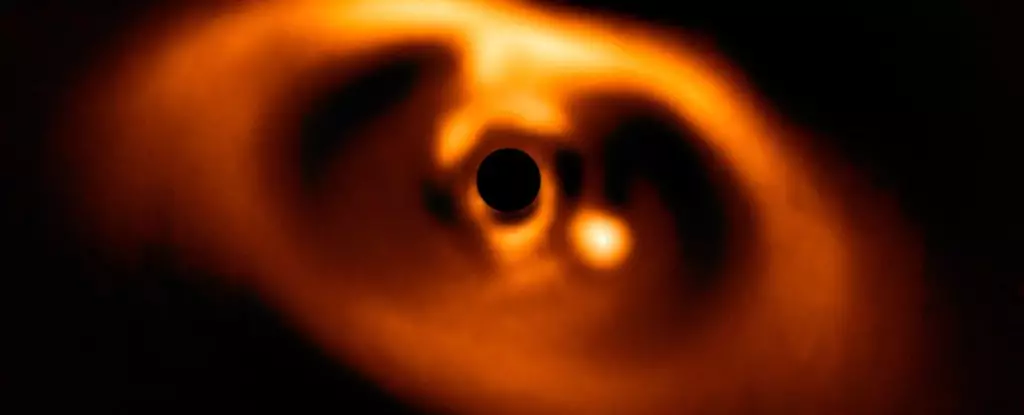The exploration of the cosmos has entered a remarkable epoch marked by an evolving understanding of planetary formation. Recent advancements in astronomical technology, including sophisticated telescopes and the integration of machine learning, are redefining our comprehension of celestial mechanics and planetary genesis. In particular, studies focusing on the exoplanet PDS 70b have illuminated critical discrepancies in the classical models of how planets coalesce around new stars, suggesting a much more intricate dynamic than previously assumed.
Historically, the Nebular Hypothesis has served as a cornerstone in the study of star systems, positing that they emerge from vast clouds of gas and dust. According to this model, as these nebulae collapse under gravity, a new star forms at the center, while leftover materials create a protoplanetary disk. The expectation is that this disk’s composition directly impacts the planets that form within it. However, a groundbreaking study led by a team from Northwestern University and other prestigious institutions reveals an unexpected divergence in the atmospheric composition of PDS 70b and its originating protoplanetary disk, challenging the idea that such systems are uniformly composed.
To arrive at their findings, researchers utilized the advanced capabilities of the Keck Planet Imager and Characterizer at the W.M. Keck Observatory to obtain detailed spectral data from PDS 70b. Their efforts not only provided insights into the atmospheric makeup of this exoplanet but also compared these findings directly with the fossilized materials of its berth—the surrounding protoplanetary disk. This study has opened new avenues for understanding how planets form in situ, under conditions that are intimately tied to their star systems.
PDS 70b is a unique case study, orbiting a young star approximately 366 light-years away. At only about five million years old, this star system offers rare visibility into the processes that accompany planet formation. For the first time, researchers could analyze the planet’s atmosphere while also assessing the gaseous composition of its natal disk, allowing for a comparative analysis that previous studies could not achieve; thus, uncovering tantalizing implications for planetary science.
The team, spearheaded by postdoctoral researcher Chih-Chun “Dino” Hsu, found that PDS 70b’s atmospheric carbon-to-oxygen ratio differed significantly from that of the protoplanetary disk. This shift not only contradicts the conventional expectations when comparing gaseous compositions but prompts a reevaluation of the theories associated with planetary development. This suggests that the interactions between a forming planet and its environment are more nuanced than initially understood, emphasizing that planet formation may involve a greater role for solid materials than mere gaseous accumulation.
To elucidate these unforeseen results, Hsu and his colleagues proposed several hypotheses. One possibility is that PDS 70b formed during a prior period when carbon levels in its disk were minimal. Alternatively, the planet may have primarily accrued materials in solid form, blending them into its eventual atmosphere. This speculation indicates that a more comprehensive model encompassing not only gaseous but also solid materials is essential for understanding planetary composition.
Moreover, the discovery of carbon monoxide and water within PDS 70b’s atmosphere raises further questions regarding the mechanisms by which these materials become incorporated into a developing planetary body. Earlier models suggested a direct relationship between disk composition and atmospheric characteristics, but the observed mismatches indicate a need for a revised framework—one that accommodates the complexities of accretion processes.
The ramifications of this study extend beyond the immediate findings regarding PDS 70b. This research sets the stage for additional inquiries into other planetary bodies in the same system, including PDS 70c. By contrasting the two planets, scientists can glean further understanding of individual formation histories and the overarching dynamics at play within this unique environment.
As astronomers continue to utilize advanced technologies to peer into the depths of young star systems, the potential for redefining our understanding of planet formation grows exponentially. The meticulous analyses of atmospheric compositions paired with a deeper comprehension of solid material accretion are poised to transform the current paradigms of planetary science. Over time, these breakthroughs could enable astronomers to define a more detailed narrative about the origin of not only specific planets but also the various factors influencing planetary systems across the universe. By weaving together insights from emerging technologies and newfound data, the scientific community may soon unlock the elusive secrets of celestial formation.


Leave a Reply